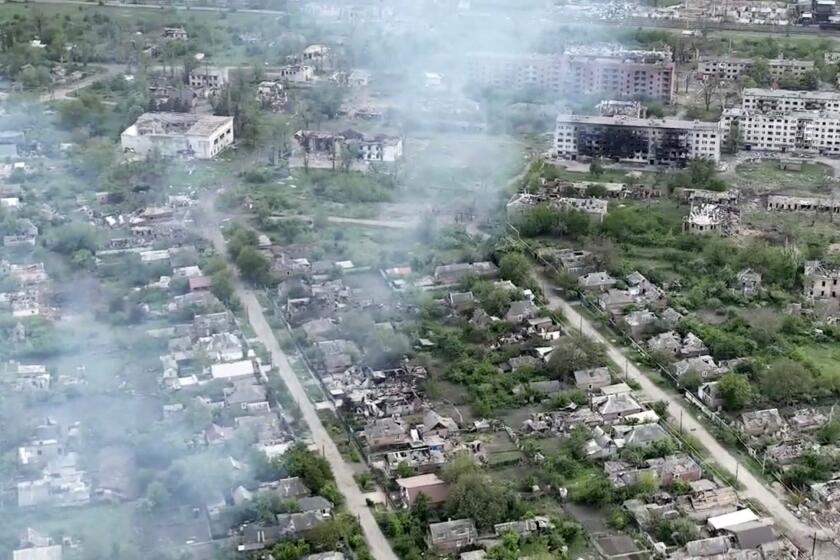Cairo Sours Over Traffic, Pollution, Population : Egypt: The real trouble could lie in the intense frustration of the thousands of young residents rebelling against a metropolis they have never come to embrace.
An Egyptian woman told the tame Cairo horror story--a dispute with a rude street cobbler over the repair of her son’s shoes--with the same intensity a New Yorker might describe a homicide.
The cobbler had demanded a deposit, objected to the small amount offered, and threw the money and the shoes back at the woman. “This snarling attitude is incredible in Cairo,” she said.
Was this the most notable change in the Middle East’s largest city, the biggest metropolis in Africa?
It had been 12 years since writer Peter Theroux had been in Cairo. “In the interim,” he reports in the National Geographic magazine, “the city’s population had nearly doubled to 13 million, and its streets were thick with pollution. Yet instead of complaining about those things, Cairenes were fretting over whether the proverbial sweet nature of the natives was eroding.”
A more pressing concern is the worst wave of Islamic violence unleashed on Cairo and the rest of the country in a decade. Well-armed militants demanding an end to secular rule in Egypt are threatening the nation’s $3-billion tourist industry.
Still, everyday life goes on. The irascible cobbler’s day had probably started with a long and bruising commute on a bus overflowing with workers, crated produce and possibly chickens, Theroux writes. From the cobbler’s curbside post, he would have breathed the blue, lead-laden air of downtown and endured the car horns and engines of what is arguably the world’s loudest city.
“As I surveyed this congested labyrinth that had replaced the lovely city I knew as a young man,” Theroux writes, “I wondered if the Cairenes themselves had changed.
“Then I came across the snake charmers. Such people still enliven the city on the Nile, plying their trade as itinerant pest controllers, offering their services door-to-door. Their prey is usually the cobra, which has ceded its place on the crowns of ancient Egypt to become a lurking city menace.”
Cairo sprawls across three of Egypt’s 26 provinces. At dawn the roads from the surrounding country are choked with groaning buses and cars. At the same hour, workers from more-distant areas surge against turnstiles of the underground Metro stations. Some are teachers or clerks who cannot afford Cairo rents; others are country people who peddle goats or bushels of garlic.
Twelve years are less than a heartbeat in this city, where tradition holds that Jesus spoke his first words. Cairo’s history is so deep and so many people walk in and out of the Cairenes’ lives that nothing seems to faze them.
Ninety percent of Cairenes originally came from villages, even if they don’t like to admit it. In the 1960s, President Gamal Abdel Nasser encouraged them to keep their village ways as a means of asserting their existence as Egyptians against the foreigners who had controlled this country for so long. Cairenes, once nearly powerless in their British- or Ottoman-ruled city, eventually came to dominate the place.
The results seem obvious: Village Egypt was erasing the big-city atmosphere of districts such as Shubra with huge rural-style families, goats, litter, loud radios and come-as-you-are street life.
But the real trouble could lie in the intense frustration of the thousands of hard-to-employ young Cairenes rebelling against a city they have never come to terms with. While the great migration to Cairo has spared them the boredom and poverty of rural Egypt, the actual volume of their migration has been a crushing job eliminator.
A late-evening stroll reveals Cairo without commuters. Even in the dark, however, the mazes of parked cars and the lack of a single empty space can be felt: The city is too full.
“Cairo’s population is growing at an amazing rate,” Walter Armbrust of the American University told Theroux. “The government is treating family planning as an information war. They use television commercials to persuade Egyptians to have fewer children.”
To house the swelling masses, thousands of rickety tenements have sprung up. Many could not withstand the worst earthquakes in Egyptian history. Perhaps half the 600 Cairenes killed by the quake last October died when poorly constructed buildings collapsed.
Cairenes who cannot afford to live in tenements go in for some creative homelessness. In a neighborhood beside the Nile, the river banks are lined with rowboats converted into populous houseboats.
Hardly less conventional is the shelter provided for a half million people in two gigantic cemeteries known as the City of the Dead. These graveyards have become a new suburb, with water and electricity.
One measure of the Cairenes’ adaptability is found in the old city’s profusion of mosques, synagogues and churches. In a region beset by centuries of religious violence, Cairo had been something of a sanctuary.
Among Arab capitals, one thing sets Cairo apart: the Israeli flag flying over an embassy.
It is not just that flights into Egypt provide sanctuary to refugees--whether from King Herod or from famine in the Sahel. Even in its hard-line socialist days, Cairo welcomed deposed monarchs such as Iran’s Shah Mohammed Reza Pahlavi.
Theroux wondered what an old woman living in a metal shack in the City of the Dead would change about Cairo.
“I wish people could make better livings in their villages,” Fatima Rashad el-Bayoumi said. “Too many people moving in, especially here in the tombs. Families keep inviting more cousins, and everyone just settles in.
More to Read
Start your day right
Sign up for Essential California for news, features and recommendations from the L.A. Times and beyond in your inbox six days a week.
You may occasionally receive promotional content from the Los Angeles Times.





